Cornelis Guldewagen, was a Haarlem mayor, known best today for his portrait by Frans Hals.

Yonker Ramp and His Sweetheart is an oil-on-canvas painting by the Dutch Golden Age painter Frans Hals, painted in 1623 and now in the Metropolitan Museum of Art, New York City. The painting has also been titled as Young Man and Woman in an Inn or Portrait of Pieter Ramp.
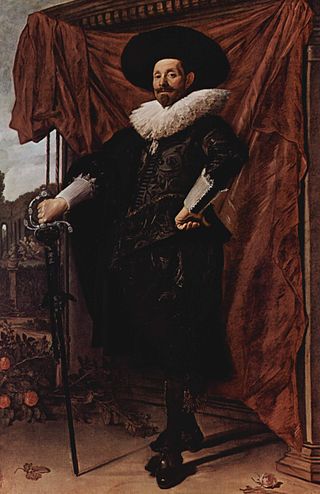
Willem van Heythuysen posing with a sword is an oil-on-canvas painting by the Dutch Golden Age painter Frans Hals, painted in 1625-1630, and now in the Alte Pinakothek, in Munich. It shows the Haarlem cloth merchant Willem van Heythuysen in a theatrical pose with a rapier.

Portrait of a Man in a Yellowish-gray Jacket is an oil-on-panel portrait painting by the Dutch Golden Age painter Frans Hals, painted in 1633 and now in the Staatliche Kunstsammlungen Dresden, Dresden.

Portrait of a Woman is an oil-on-canvas portrait painting by the Dutch Golden Age painter Frans Hals, painted ca.1635–1638 and now in the National Gallery at London.

Marriage Portrait of Isaac Massa and Beatrix van der Laen is a painting by the Dutch Golden Age painter Frans Hals, painted c. 1622 and now in the Rijksmuseum, Amsterdam. The couple has been identified as Isaac Massa and his bride Beatrix van der Laen.
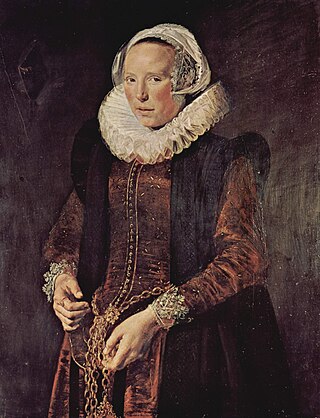
Portrait of a Woman Standing is a painting by the Dutch Golden Age painter Frans Hals, painted in 1610–1615 and now in Chatsworth House. It is considered a pendant portrait, but the sitter is unknown and therefore the pendant is not certain.
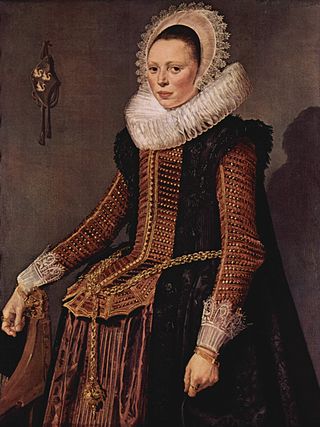
Portrait of a Woman Standing (Kassel) is a painting by the Dutch Golden Age painter Frans Hals, painted in 1618–1620 and now in Gemäldegalerie Alte Meister (Kassel). It is considered a pendant portrait to the Portrait of a Man Standing, in the same museum.

Catharina Both van der Eem is a painting by the Dutch Golden Age painter Frans Hals, painted in 1620 and now in Louvre Museum. It is considered a pendant portrait to the Portrait of Paulus van Beresteyn, in the same museum.
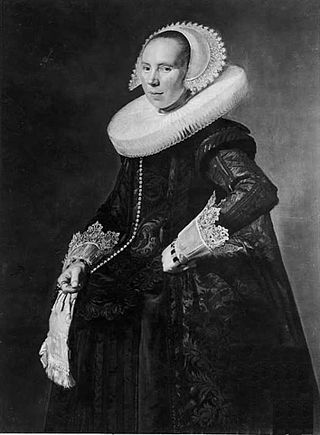
Portrait of Cunera van Baersdorp is an oil-on-panel painting by the Dutch Golden Age painter Frans Hals, painted in 1625 and now in a private collection. It is considered a pendant portrait to the Portrait of a Man Standing, now identified as Cunera's husband Michiel de Wael.

Portrait of Cornelia Claesdr. Vooght is a painting by the Dutch Golden Age painter Frans Hals, painted in 1631 and now in the Frans Hals Museum. The painting is an oil on panel and is considered a pendant portrait to that of her husband, the Haarlem brewer and mayor Nicolaes Woutersz van der Meer.

Portrait of Catharina Brugman is an oil-on-canvas painting by the Dutch Golden Age painter Frans Hals, painted in 1634 and now in a private collection. It is considered a pendant to the portrait of Catharina's husband Tieleman Roosterman.

Portrait of Feyntje van Steenkiste is an oil-on-canvas painting by the Dutch Golden Age painter Frans Hals, painted around 1635 and now in the Rijksmuseum, in Amsterdam. It is considered a pendant to the portrait of Feyntje's husband Lucas de Clercq.

Portrait of Maria Pietersdochter Olycan is an oil-on-canvas painting by the Dutch Golden Age painter Frans Hals, painted in 1638, now in the São Paulo Museum of Art. It is considered a pendant to the portrait of Maria's husband Andries van Hoorn.

Portrait of Hylck Boner is an oil-on-canvas painting by the Dutch Golden Age painter Frans Hals, painted in 1635 and now in the Frick Collection. It is considered a pendant to the portrait of Hylck's husband Johannes Saeckma.
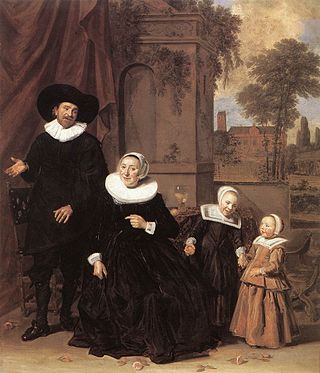
Portrait of a Dutch Family is an oil-on-canvas painting by the Dutch Golden Age painter Frans Hals, painted c. 1635 and now in the Cincinnati Art Museum, Cincinnati.

Portrait of Mrs. Bodolphe is an oil-on-canvas painting by the Dutch Golden Age painter Frans Hals, painted in 1643 as half of a pair of pendant marriage portraits and is still together with its pendant in the Yale University Art Gallery, New Haven, Connecticut.

Portrait of a Man is an oil-on-canvas painting by the Dutch Golden Age painter Frans Hals, painted c. 1660 and now in the Frick Collection, New York City. The man has been mistakenly identified as Michiel de Ruyter.

Portrait of Stephan Geraedts, Husband of Isabella Coymans is a late oil on canvas painting by the Dutch Golden Age painter Frans Hals, made when the artist was about 70. The painting is one of a pendant pair of wedding portraits, now separated. Hals probably painted the present portrait, Stephanus Geraerdts', an alderman of Haarlem, which was designed to be on the left, and the accompanying portrait of his wife Isabella Coymans around 1650–1652, six or seven years after their marriage in 1644. Isabella's portrait is now in a private collection in Paris.

Jacob Ruychaver was a trader in the service of the Dutch West India Company, who rose to the rank of Director-General of the Dutch Gold Coast twice.






















